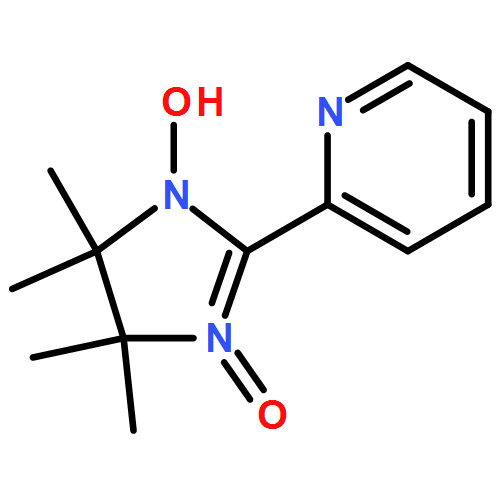Co-reporter: Xue-Lan Mei, Yue Ma, Li-Cun Li and Dai-Zheng Liao
pp: NaN511-511
Publication Date(Web):2011/10/31
DOI: 10.1039/C1DT11795E
Three new 2p–4f complexes of [Ln(acac)3(NIT-2Py)]·0.5NIT-2Py [Ln(III) = Gd(1), Dy(2)] and [Dy(tfa)3(NIT-2Py)]·0.5C7H16 (3) (NIT-2Py = 2-(2′-pyridyl)- 4,4,5,5-tetramethylimidazoline-1-oxyl-3-oxide; acac = acetylacetonate and tfa = trifluoroacetylacetonate) have been synthesized, and structurally and magnetically characterized. The X-ray structural analysis exhibits that the three complexes show similar mononuclear structures, in which NIT-2Py radical chelates the Ln(III) ion through the oxygen atom of the NO group and the nitrogen atom from the pyridine ring. The static magnetic measurements on the three complexes exhibit ferromagnetic coupling between the lanthanide ion and the radical. Compared to the silence of the out-of-phase ac susceptibility of complex 3, the magnetic relaxation behavior of complex 2 is observed, suggesting single-molecule magnet behavior. The different magnetic relaxation behaviours of 2 and 3 are due to their slightly different crystal structure around the Dy(III) ions. It was demonstrated that the spin dynamic can be modified by the careful adjustment of the ligand field around the metal center.
Co-reporter: Xue-Lan Mei, Yue Ma, Li-Cun Li and Dai-Zheng Liao
pp: 505-511
Publication Date(Web):31 Oct 2011
DOI: 10.1039/C1DT11795E
Three new 2p–4f complexes of [Ln(acac)3(NIT-2Py)]·0.5NIT-2Py [Ln(III) = Gd(1), Dy(2)] and [Dy(tfa)3(NIT-2Py)]·0.5C7H16 (3) (NIT-2Py = 2-(2′-pyridyl)- 4,4,5,5-tetramethylimidazoline-1-oxyl-3-oxide; acac = acetylacetonate and tfa = trifluoroacetylacetonate) have been synthesized, and structurally and magnetically characterized. The X-ray structural analysis exhibits that the three complexes show similar mononuclear structures, in which NIT-2Py radical chelates the Ln(III) ion through the oxygen atom of the NO group and the nitrogen atom from the pyridine ring. The static magnetic measurements on the three complexes exhibit ferromagnetic coupling between the lanthanide ion and the radical. Compared to the silence of the out-of-phase ac susceptibility of complex 3, the magnetic relaxation behavior of complex 2 is observed, suggesting single-molecule magnet behavior. The different magnetic relaxation behaviours of 2 and 3 are due to their slightly different crystal structure around the Dy(III) ions. It was demonstrated that the spin dynamic can be modified by the careful adjustment of the ligand field around the metal center.
